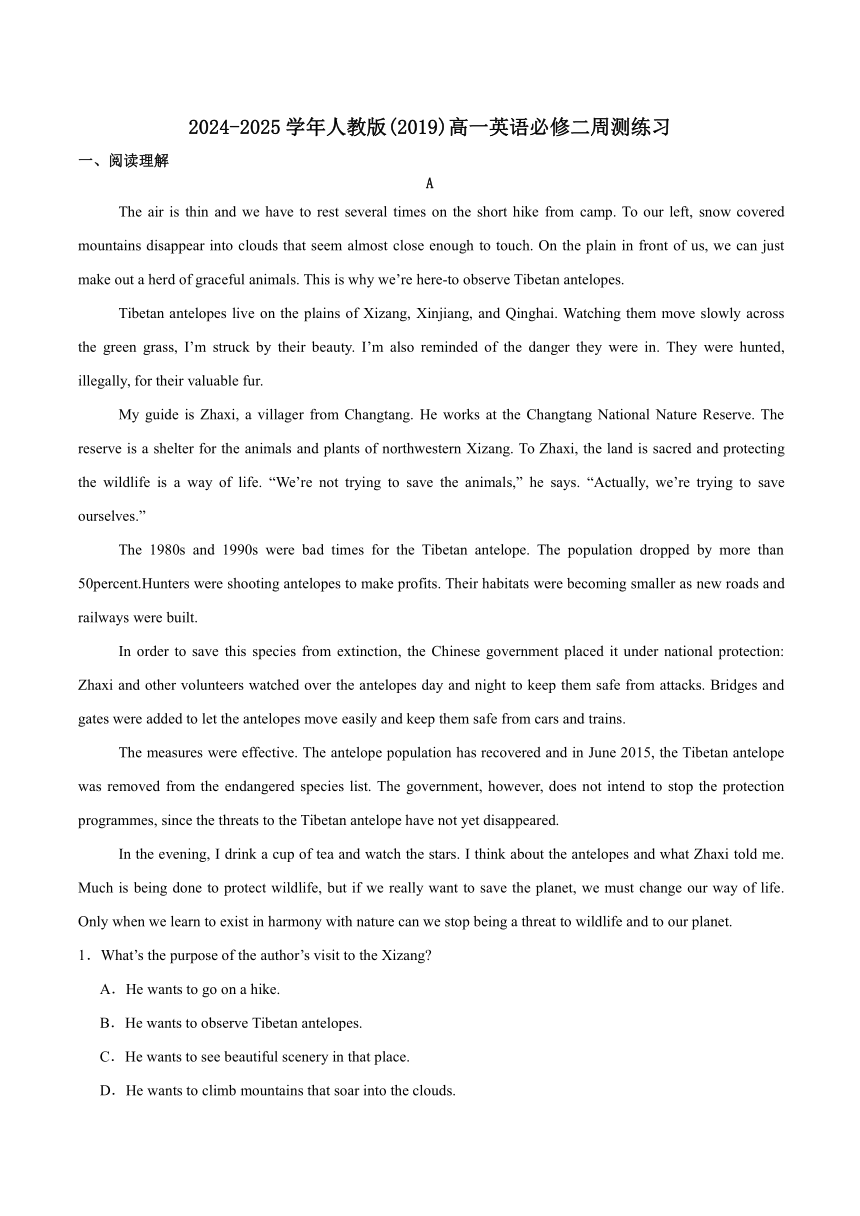
2024-2025学年人教版(2019)高一英语必修二周测练习 阅读理解 A The air is thin and we have to rest several times on the short hike from camp. To our left, snow covered mountains disappear into clouds that seem almost close enough to touch. On the plain in front of us, we can just make out a herd of graceful animals. This is why we’re here-to observe Tibetan antelopes. Tibetan antelopes live on the plains of Xizang, Xinjiang, and Qinghai. Watching them move slowly across the green grass, I’m struck by their beauty. I’m also reminded of the danger they were in. They were hunted, illegally, for their valuable fur. My guide is Zhaxi, a villager from Changtang. He works at the Changtang National Nature Reserve. The reserve is a shelter for the animals and plants of northwestern Xizang. To Zhaxi, the land is sacred and protecting the wildlife is a way of life. “We’re not trying to save the animals,” he says. “Actually, we’re trying to save ourselves.” The 1980s and 1990s were bad times for the Tibetan antelope. The population dropped by more than 50percent.Hunters were shooting antelopes to make profits. Their habitats were becoming smaller as new roads and railways were built. In order to save this species from extinction, the Chinese government placed it under national protection: Zhaxi and other volunteers watched over the antelopes day and night to keep them safe from attacks. Bridges and gates were added to let the antelopes move easily and keep them safe from cars and trains. The measures were effective. The antelope population has recovered and in June 2015, the Tibetan antelope was removed from the endangered species list. The government, however, does not intend to stop the protection programmes, since the threats to the Tibetan antelope have not yet disappeared. In the evening, I drink a cup of tea and watch the stars. I think about the antelopes and what Zhaxi told me. Much is being done to protect wildlife, but if we really want to save the planet, we must change our way of life. Only when we learn to exist in harmony with nature can we stop being a threat to wildlife and to our planet. 1.What’s the purpose of the author’s visit to the Xizang A.He wants to go on a hike. B.He wants to observe Tibetan antelopes. C.He wants to see beautiful scenery in that place. D.He wants to climb mountains that soar into the clouds. 2.Which of the following places is NOT the habitat of the Tibetan antelope A.The plains of Xizang. B.The plains of Qinghai. C.The plains of Xinjiang. D.The mountainous area of Xizang. 3.What can be inferred from the last but one paragraph A.The threats to the Tibetan antelope still exist. B.The government has stopped protecting antelopes. C.The Tibetan antelope species is still endangered. D.The Tibetan antelope has been moved out of the reserve. B All living things on the earth need other living things to live. Nothing lives alone. Most animals must live in a group, and even a plant grows close together wi ... ...
~~ 您好,已阅读到文档的结尾了 ~~